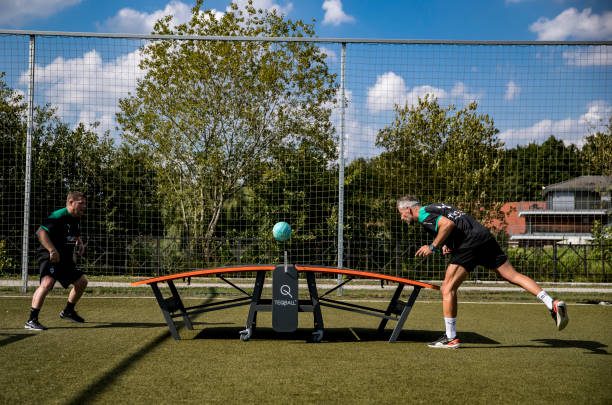
Table of Contents
What is Wallyball?
Wallyball is a thrilling mash-up of volleyball and racquetball played on a modified court with a net. In this game, unpredictable bounces off the walls create a thrilling and dynamic aspect.
It causes lightning-fast reactions, agility, collaboration, and communication. Wallyball’s high-energy style and dramatic rallies enthrall players, while its innovative moves cannot astonish spectators. Whether playing for fun or in competitive leagues, wallyball keeps players on their toes.
It gives volleyball fans a new twist and racquetball players an intriguing team dynamic. Wallyball promises hours of fun and amazing exercise with its fast-paced action and surprising bounces. Prepare to be surprised as you dive, spike, and plot your way to success in this adrenaline-pumping game.
Objective of Wallyball
Scoring More Points:
- The fundamental purpose of wallyball is to outscore the opposition team.
- Teams strive to gain more points by adopting strategic plays.
Modified Volleyball on a Racquetball Court:
- Wallyball is a modified version of volleyball played on a racquetball court.
- Players may use the walls as playing surfaces, providing a new aspect to the game.
Adaptation of Traditional Strategies:
- It is possible to achieve success in wallyball by employing common volleyball principles.
- Defining defined defensive and offensive tasks improves team effectiveness.
- It provided tactical choices by varying the number of touches required before putting the ball over the net.
Curving Techniques Restriction:
- In wallyball, players cannot use curving tactics like spiking, and the paintbrush technique is not allowed.
- It disallowed intentional ball curving, fostering fair and regulated gaming.
- When a player strikes the ball off-center, it allows spin, providing an alternative tactic.
The Importance of Controlled Spin and Manners:
- As long as you are curving, you may use controlled spin.
- Hitting the ball off-center creates spin, which adds elegance and unpredictability.
- Players must master spin while adhering to regulations that prevent excessive curving or spinning.
History
Wallyball, an exhilarating sport that emerged in the late 1970s, incorporates elements from both volleyball and racquetball, resulting in a dynamic and fast-paced game. Joe Garcia created the game as a thrilling and high-energy substitute for traditional volleyball. The sport swiftly grew in popularity, spreading across the United States and globally.
Wallyball’s popularity can be ascribed to its attraction to a diverse variety of players, including volleyball and racquetball lovers, according to Tony Almond’s book “The Complete Book of Wallyball.” The fast-paced nature of the sport, along with the utilization of walls as an active playing surface, lends a distinct twist to regular volleyball.
Wallyball tournaments and leagues arose, prompting the establishment of regulatory bodies such as the World Wallyball Federation. Wallyball is still popular among fans globally, offering a thrilling and competitive combination of two popular sports.
Governing body
There is no worldwide governing body for wallyball. The American Wallyball Association (AWA) regulates all national-level tournaments in the United States. In 1989, it actively worked to support, preserve, and advance the sport globally. The sport organizes various competitions and tournaments.
Who Can Play Wallyball?
Players combine racquetball and volleyball to play wallyball on an enclosed racquetball court. It provides a fast-paced environment for gamers of all ages and ability levels.
Teams usually comprise two to six players. But American Association allows up to four players.
It is perfect for both casual and structured play because it suits all skill levels.
The game’s intensity and small playing space require athletes to possess general athletic talents and coordination. There are no restrictions based on gender or age.
This exciting indoor exercise actively engages individuals, providing them with enjoyment, promoting physical health, and enabling participation in leagues and contests.
Pieces of equipment
Wallyball Ball
The Wallyball ball explodes into the court, sparking enthusiasm in each player’s heart. Its sleek, aerodynamic shape glides through the air smoothly, capturing everyone’s attention.
The spherical ball, with a weight ranging from 9 to 10 ounces (255 to 283 g), possesses a circumference of 25 to 27 inches (64 to 69 cm), which is equivalent to that of a standard volleyball.

With each substantial spike and flawless set, the ball pulsates with sheer power, offering an adrenaline rush. Its rough surface provides a secure hold, giving players confidence as they leap, dive, and slide around the floor.
It’s more than just a ball; it’s a conduit of unshakable enthusiasm that stokes the fires of every Wallyball fan.
Court
A Wallyball court is a specifically built indoor court. We use it for playing fast-paced and dynamic sports. The court proportions are identical to those of a regular volleyball court, spanning 40 feet in length and 20 feet in width.
The court has 20-foot-high walls on either side that serve as game boundaries. Wallyball nets are three feet (0.91 meters) high and hang 8 feet above the floor for men and 7 feet 6 inches above for women.

Each side has two service spaces that run over the whole width of the court and 1 foot from each end wall.
Players actively engage by striking the ball off the walls to keep it in play, providing a thrilling and unpredictable aspect.
Shoe
It is best for the activity, providing comfort, support, and agility. The lightweight structure of these shoes allows for fast lateral movements and direction changes.

Material that breathes keeps feet cool and dry. Non-marking rubber shoes give good indoor traction. In addition, cushioned midsoles reduce impact forces, lowering the risk of ankle sprains.
Wallyball shoes are sports footwear designed with player performance and injury prevention in mind.
Nets
Wallyball nets are an integral component. It combines elements of volleyball and racquetball. These wallyball-specific nettings assist the sport’s dynamic gameplay.
It is 32 feet wide and 3 feet tall, according to the standard measurements of a volleyball court. The net has a top cable that passes through several metal grommets to stabilize and achieve optimal tension.

Net anchors hooks or straps to robust vertical posts or walls. Wallyball nets endure hard impacts and continual player engagement.
The design of these structures allows for quick setup and disassembly, making them suitable for leisure and competitive play.
Kneepads
Wallyball kneepads are vital protective equipment developed for fast-paced sports. These kneepads, made of durable materials like neoprene, provide flexibility and unfettered mobility on the court.

They include reinforced padding around the knee area to cushion blows and reduce the likelihood of injuries such as bruising and strains. The adjustable straps with secure closures provide a customized and solid fit.
Wallyball kneepads are well-known for their practicality, durability, and comfort, making them essential equipment for serious players looking to flourish in this fascinating sport.
Rules
Sure, here are the official wallyball rules:
Basic Rules
- A team comprises a minimum of two players.
- In general, matches will have two out of three games to determine the winner or three out of five games for a complete victory.
- It must serve the ball from behind the service line.
- The ball can hit the walls.
- It takes three hits for a team to return the ball over the net.
- Players cannot touch the net.
- It scored a point when the ball hit the floor on the opponent’s side.
Court and Equipment
- The court is a racquetball court with a volleyball net.
- A line that is 1.5 inches (3.75 cm) broad marks the service area, and it spans the whole width of the court.
- The distance between the line and the rear and front walls will be three (3) feet (90.00 cm).
- The ball is a rubber ball. It is 25-27 centimeters in circumference and weighs 9-10 ounces.
Scoring
- A team scores a point when the ball hits the floor on the opponent’s side.
- Every game in a match is played best of three.
- The first team to score 25 points wins the game(rally scoring).
- Both teams are frozen when the serving team achieves the freezing point.
- The team that wins the serve gets an additional point at the next side-out.
- Only the serving team can score points after the side-out.
- A point is awarded to the winner of each volley until one team reaches the freezing point.
- The freezing point is three points less than the number needed to win a game.
- Once a team reaches the freezing point, points are only awarded to the serving team if they win the volley.
Service
- Players must make the service from behind the service line.
- Three feet separate the service area from the court’s ends.
- Hit the ball over the net and ensure it lands in the opponent’s court.
- The serving team members must not touch the ball as it passes over the net.
- The ball must avoid touching the net or any net hardware.
- Before being played or landing on the floor, the ball must not touch two or more walls.
- The ball must not contact the opponent’s back wall.
- The ball must not hit the ceiling of the court.
Rotation
- After each serves, the players rotate clockwise in one position.
- The server always serves from the right-hand side of the court.
Substitutions
- Substitutions are allowed at any time.
- There can be a total of two substitutions in each game.
- You may substitute only when the ball is dead and when the playing caption requests it.
- The team will be charged with a time-out if they do not make the substitution during a designated time-out.
- The player who is being substituted must leave the court immediately.
- Substitutes must enter the court instantly.
Fouls
- A team that commits a foul loses the point.
- Some common fouls include:
- Hitting the ball out of bounds.
- Double-hitting the ball.
- Carrying the ball.
- Throwing the ball.
- Touching the net.
- Touching the floor on the opponent’s side of the court.
- Using your feet to hit the ball.
- Using your body to block the ball.
Sportsmanship
- It expects that players behave in a sporting manner.
- It may eject any player who exhibits unsportsmanlike conduct from the game.
Officials
- One or two referees officiate a game of it.
- Referees enforce the rules and ensure fair play during the game.
Additional Rules
- Players cannot double-hit the ball.
- Players cannot carry the ball.
- In this game, players cannot throw the ball.
- Players cannot touch the floor on the opponent’s side.
- Players cannot use their feet to hit the ball.
- Body blocking is not allowed.
To know these rules, you can start a gameplay.
How to play?
Sure! Here’s a step-by-step tutorial for it:
Gather all the required equipment
You’ll need the following items to play it:
- A wallyball (a sort of ball made particularly for this activity)
- In wallyball, there is a net that is like a volleyball net but is lower.
- A wallyball court is a modified racquetball or squash court with a back wall.
Form the teams
Determine how many players each squad will have. Two teams of three to six people can play it. Determine the serving order after creating the teams.
Prepare the court
Set up the wallyball net in the center of the court. The net height for a regular volleyball net should be lower, usually ranging from 6 to 7 feet. Make sure the court is clear of any obstacles.
Start the game
The match begins with a serve. The server, positioned behind the back boundary line in the serving area, serves the wallyball over the net to the other team’s side. The server must serve the ball either underhand or overhand.
Gather the ball
The receiving team must hit the ball back over the net within three hits when they serve it. The ball has to go over the net and land inside the boundaries of the court.
Keep the rally going
Both sides continue to smash the ball back and forth, attempting to keep it from touching the ground on their side of the court. Players can strike the ball with any body part except holding or carrying it.
Evaluation
An error or failure to return the ball earns one team point. The serving team gets a point if the receiving team fails to return the ball effectively. The receiving team wins the right to serve if they successfully return the ball.
Switch positions
The serving team switches positions clockwise after each point. Each player has the opportunity to serve consecutively.
Keep playing
Play until one team achieves the specified winning score. Players typically prefer winning scores ranging from 11 to 25 points.
Win the game
The first team to attain the winning score wins the game. In some circumstances, a team must win by a two-point margin.
You can play a game if you follow these procedures. Enjoy your game!
Strategy
Wallyball is a variant of volleyball. Players play on a racquetball court, utilizing the walls strategically. Here are some crucial methods and suggestions for improving your wallyball performance:
Communications
Effective communication plays a crucial role in every team sport. Communicate with your teammates on positions, plays, and possible threats regularly.
Court positioning
Court location is crucial because, on a small ground, it occurs. Spread out and efficiently cover the court to limit open spots for the opposing side to exploit.
Wall utilization
Smartly use of the walls. Confuse your opponents or create surprising angles by bouncing the ball against the walls and utilizing them effectively. Using offensive or defensive plays could be a practical approach.
Quick reactions
You need quick responses because the court size is smaller, and the game is faster. You must be ready to move swiftly and adapt to sudden shifts in the ball’s path.
Serve placement
In wallyball, serve placement may be a potent weapon. Try serving to corners or difficult receiving locations to put pressure on the opposition right away.
Set plays and tactics
Work with your team to develop set plays and strategies. These can involve coordinated attacks, defensive formations, or particular plays designed to exploit flaws in the other team’s defense.
Anticipate wall rebounds
Be prepared for surprising bounces off the walls. To execute accurate passes or assaults, anticipate that the ball might bounce off the walls at different angles.
Teamwork
Work cohesively with your squad, acknowledging each player’s talents and shortcomings. To enhance your team’s performance, coordinate motions, communicate clearly, and encourage one another.
Here are some extra Wallyball strategies:
- Use your body to block the ball. If you’re in a favorable position, you can utilize your body to keep the ball from going over the net.
- A technique like this can effectively prevent the opposition from scoring.
- To navigate around the court, you should use your feet. In this game, moving swiftly across the court is essential because it is a fast-paced game.
- Use your feet to get into position to strike the ball and defend against the opposing team’s onslaught.
- Consider the game with your brain. Wallyball is a cerebral sport. You must be able to think swiftly and make rapid judgments.
- Maintain focus on the ball, your teammates, and the other team.
Please remain vigilant of your surroundings and apply your gaming expertise to execute the best possible moves.
In which regions or areas is wallyball most popular?
Wallyball is a hybrid sport that combines aspects of volleyball and racquetball. It is played on a racquetball court with a volleyball net. The game is similar to volleyball, except that players may hit the ball off the walls and ceiling. Wallyball is a popular sport in the United States, mainly in the East. There are approximately 1,000 wallyball courts in the United States, and the sport is gaining popularity globally.
Why wallyball is so popular?
Here are some of the reasons why wallyball is so popular:
- Every age group and ability level can enjoy this fun and demanding activity.
- It’s a terrific way to get some exercise and keep in shape.
- Friends and family can enjoy this sociable sport together.
- It is a reasonably priced sport to participate in.
Conclusion
In a nutshell, wallyball is an entertaining activity that requires complete concentration and unleashes your competitive spirit. It’s an experience unlike any other, with fast-paced action, strategic gaming, and heart-pounding thrills.
Don’t pass up the chance to participate in this fascinating sport. Feel the excitement as you dive, spike, and plot your way to victory. Step onto the court, accept the challenge, and let it fire your enthusiasm for competitive, adrenaline-fueled sports.
Are you ready to release your inner champion? Take the plunge and explore the thrills of wallyball today.
Thank you for dedicating your time to reading this. Please leave your suggestions below, and Sports Dribble will respond on Facebook, Instagram, and Twitter.

My name is Krishanu Das the founder of the Sports Dribble.
I am Accountant by profession but a Sports Blogger by passion.
I am passionate about sharing my all knowledge and experiences of sports, with my readers and every sports enthusiast.
Discover more from SPORTS DRIBBLE
Subscribe to get the latest posts sent to your email.


